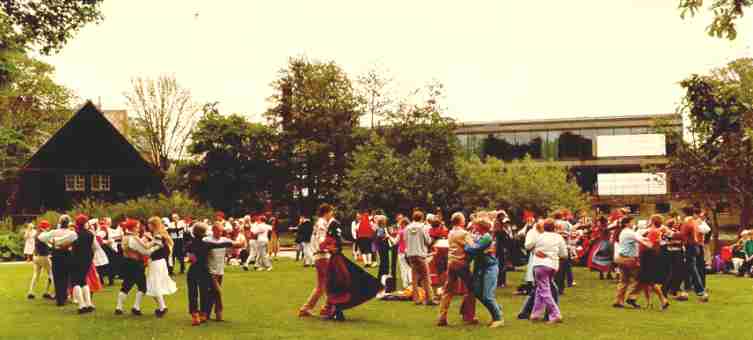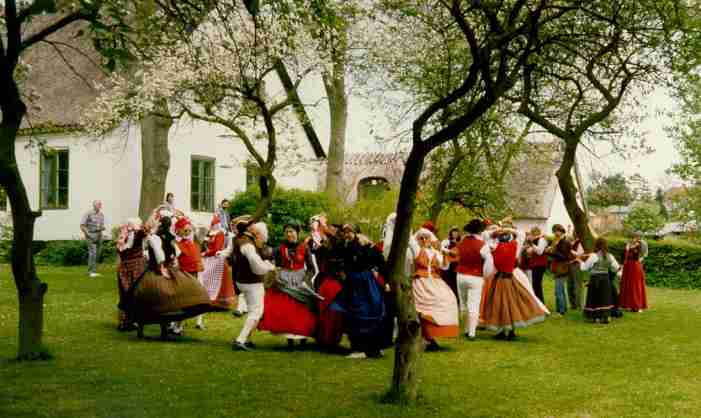
6-tur fra Vendsyssel (6-trip North) |
| Niels Mejlhede Jensen, Bøgeløvsvej 4, 2830 Virum, Denmark. e-mail (web master) |
CONTENTS: (remember: you can use Ctrl Home in usual browsers to get to the top of this page, to the links here)

Photo 1 of this week: quadrille dance performed in folklore costumes
under the fruit trees in blossom in a farm garden in Lundtofte Village
north of Copenhagen. The occasion is the festivity "Riding Summer into
Village", where part of the show is folk dancers and musicians coming on
horse drawn wagons to visit the farms and other places of the village.
Then we are served "Apple flour pan balls" (æbleskiver) dipped in
sugar flour and jam, at every farm we visit. As thank you to the farmer
(standing to the left) we perform this dance, with pleasure. (I was supposed
to be the fore player of a small band of 10 in the background to the right,
but with such good musicians nobody noticed that I sneaked away to take
this picture).

Photo 2 of this week: dance with couple wise swing steps on grass with Spillemandsdansen (Fiddlers' Dance) in front of our local library in Lyngby north of Copenhagen.
Story 1: In 1969 I graduated as civil engineer and started as a PhD student at the Technical University in Copenhagen. With my non academic background there were high expectations to the spirits of the researchers at this divine place. The same fiscal year the institute I belonged to had not been able to use all the money it was granted for instruments. (The institute is scientifically high ranking). The fiscal year coming to a close there was a surplus equivalent to a little more than one year's salary of a research engineer. And now there was a danger of the money going back to the taxpayers. The yearly returning financial problem. For this amount the institute then bought a special calculator with certain automatic functions in adding and multiplying, impressive at the time, but nothing compared to the small pocket computers of 5 years later. I and another young person were the only two that ever could learn how to use this machine, just for the fun, because we used the big IBM computer at the university for real calculations. This attitude towards use of the taxpayers' money was all too common, and the story here is nothing notable, and the amount in this context insignificant. The taxpayers do never blame the professors for the excessive money use. They blame the students for their high cost.
Story 2: About the same time a relative in my wife's family had
a visit from the authorities. She lives not so far from Copenhagen on a
small not so modern farm with hilly grass land where she has 15 sheep.
The thatched roofed farm home is open to visitors to come there and have
coffee in the garden or in the living room for a normal price. The coffee
is made on an old time stove, so even with not so much coffee sold there
is good occupation. People may park on her land, take a walk in the nearby
forest and then hopefully by a cup of coffee afterwards. Now she is rich,
also in money, 90 years old, because she gets her old age state pension.
People in town complain that they cannot live on that poor pension, but
she, as so many in the countryside, save money every month from that pension,
because they are not used to use money. So she even had an indoor toilet
made a couple of years ago, as her legs got bad and she could no longer
walk across the yard. Not a heated bathroom with hot water and hand wash,
no, this you get from the kitchen stove. On the wall in her kitchen she
has proudly framed her now honorary membership of the local Conservatives,
the traditional political party for the upper class and royalists. Before
her old age pension the income came from the 15 sheep, + the about 15 cups
of coffee sold twice a week. She has always been very reliable to everybody,
so the yearly income she could report for taxation was limited, as you
may understand. This income was much below the Danish minimum standard
of living, the taxation authorities found out. So one day they paid her
a visit. Did they then come with a bag of money to bring her standard of
living up to normal here in welfare Denmark? No, they did bring the bag
all right, but that was to take money away, needed for e.g. the Technical
University. But when they looked around, sniffed into the outdoor toilet,
it was not gold they found.
Dance of the week, 1999, March 29:
The melody can be heard in midi on computer piano in my tempo (if you
have a sound card). (The melody will loop here until you stop it. In the
table below it will play once). (I have not played the tunes here with
the "drive" I want for dance music).
| 1 | melody | the traditional good dancing melody, polished through generations of use on the fiddle | |
| . | chord
text |
Midi metronome:
dotted crotchet = 100 crotchet = 150 |
simple (folk music) chords, natural for playing the accordion;
these chords are used to make the other parts or voices in triad harmony; there should be no tension from dissonance anywhere including in octave |
| 2 | A | (Above), parallel part nearest above in third or little more above | |
| 3 | B | (Below), parallel part nearest below in third or little more below | |
| 4 | ns | simple n part; often with the tonic feeling and often with the basic dance rhythm ("motor part") | |
| 5 | C1 | C parts are made from A and B parts, and so they are two parts to the melody | |
| 6 | C2 | C2 is less simple than C1 | |
| 7 | C3 | . | |
| 8 | C4 | . | |
| 9 | mod =
contra part |
voice up and down (mostly) contra to the melody; it is also made from A and B | |
| 10 | n1 | n is a less constricted part, and tones from the melody are freely included | |
| 11 | n2 | . | |
| 12 | n3 | . | |
| 13 | blank | . | blank staff for making your own part according to the principles here |
(The midi music is not repeated, except for 1' and 2' voltas).
Use also octave, up and down.
Where wanted, notes can be changed according to the principles (use
a colour pencil), e.g. to improve the B part with some notes from
A.
The music is aimed at dancing, so part of the orchestra can be the
underlying "motor" when another instrument group is playing its "solo"
part (improvisation) as one of the many repetitions.
The double bass may play its usual notes, because of its low pitch.
It is better to choose a more simple part and play it well.
(It would be better to have the music on 3 pages, because it consists
of 3 phrases and the notes here are too congested).
Accordion: beats per bar: 2+2: that is in 6/8: a marked root
on beat 1 and 4, and a light chord on beat 3 and 6. Never anything on beat
2 and 5, it is not waltz. And it is also not a calm song in 6/8 with only
1+1 beats per bar (= measure). This is a dynamic dance in 6/8 for swing
steps (or buzz steps). The chasse steps are also danced in 6/8, i.e. uneven
steps compared to chasse in 2/4.
(Help coming back from that note
sheet: CLICK the note sheet to come back to this page, or just close
the note window.
Remember: the note sheet opens in a new separate window, and that may
cover the whole screen. The back button in the tools bar does probably
not work because the window is new, with no history. All you see on the
page are notes because I have placed no link back here for not disturbing
easy submitting to the printer. Close the note window with a click at the
top or with Alt F4, or minimize or reduce the window, or ..., and you are
back to the main page that was there behind all the time).